The Archos G9 Tablet Reviews: Fast Enough
by Jason Inofuentes on May 23, 2012 12:45 PM ESTIn the 10 months since we first heard that Archos would be leveraging the 1.5 GHz TI OMAP 4460 in their tablet line, our excitement has waned. We’ve seen tablets sporting Samsung’s Exynos, NVIDIA’s Tegra 3 and even played with some Krait tablets, all of which can seriously outperform TI’s current gen champ. But this performance sure is nice. To review, TI’s OMAP 4460 includes two ARM Cortex-A9 cores, and Imagination Technologies’ PowerVR SGX540 all on a 45 nm process. The lesser kin to our subject is the TI OMAP 4430, though to look at their spec sheets they should only differ in clock speeds, with the 4430 topping out at 1.2 GHz on the CPU and 304 MHz on the GPU and the 4460 topping out at 1.5 GHz and 384 MHz, respectively.
So, if the two OMAP 4 variants ultimately differ by their 25% clock difference, we should see a similar delta in performance. As always, we start with our JavaScript benchmarks to gauge CPU performance. First, SunSpider and its js time trials.
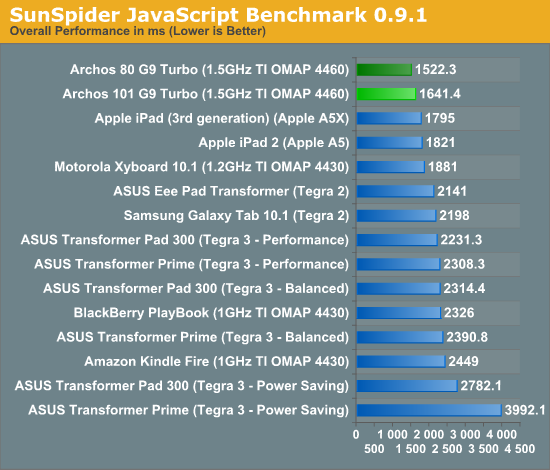
Our hands-on time with the Motorola Xyboard gave us a hint at what to expect. At 1.2 GHz OMAP 4 provides excellent JavaScript performance. At 1.5 GHz, we have a new king of the hill for this particular benchmark. It's hard to say whether there's some optimization trickery at work here, but browsing performance on these tablets was generally excellent.
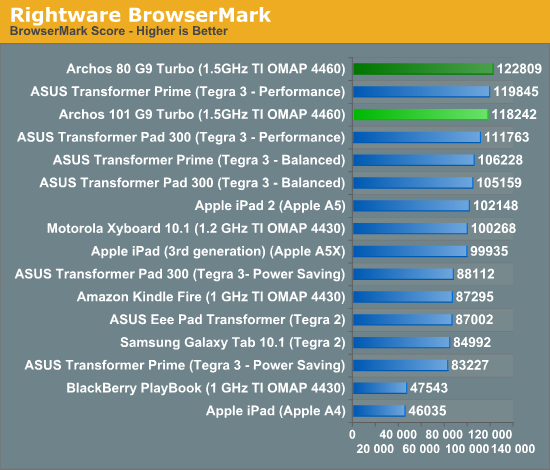
Rightware's Browsermark is another js test that paints the same picture. In both of these tests the delta between the Xyboard and the G9 was about 25% so the leads correlate with the clockspeed advantage. The result is, at least in JavaScript performance, we have the world's fastest tablets.
So how does that old stand-by the SGX 540 fare now that it's been cranked to 384 MHz? We start with GLBenchmark and their off-screen tests, Egypt and Pro. Any test at device resolution would unfairly favor the smaller 80 G9 because of its lower resolution.
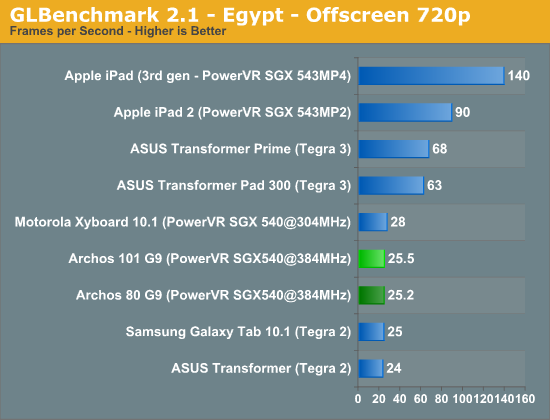
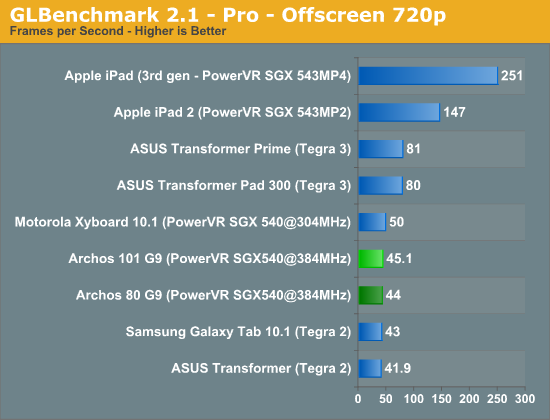
Not quite what we expected. Here the G9's fall behind the lower clocked Xyboard by roughly 10%, and certainly don't demonstrate the performance advantage they showed in the JavaScript tests.
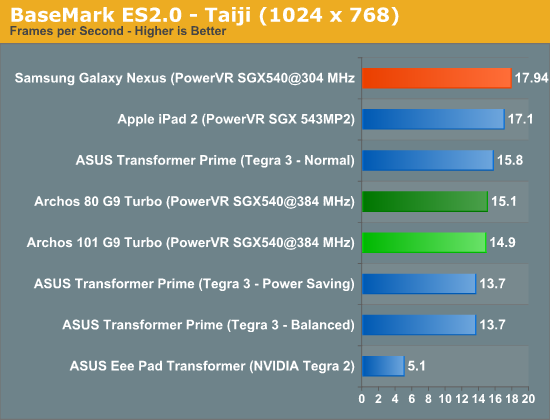
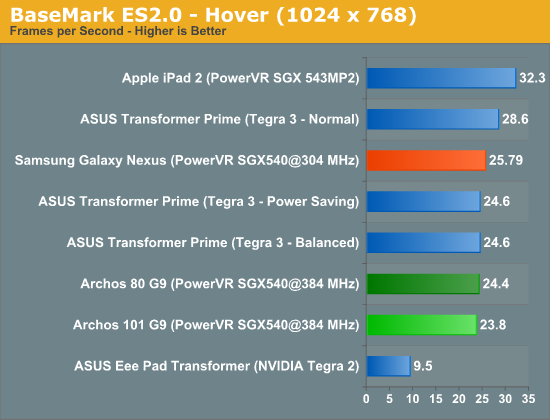
BaseMark's results show much of the same. We didn't record data for the Xyboard, but we did have it for the Galaxy Nexus and its equivalently clocked OMAP 4460. The Nexus bests all but the iPad 2, but the G9's continue to falter by about 10%.
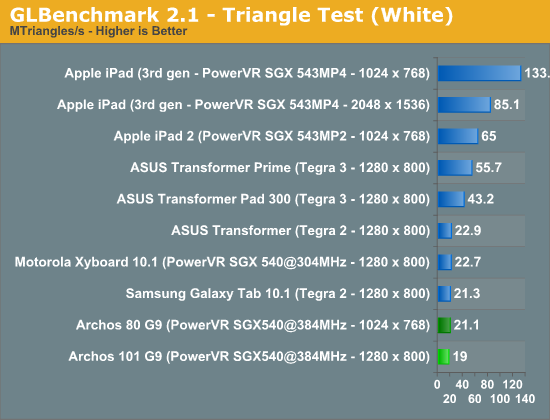
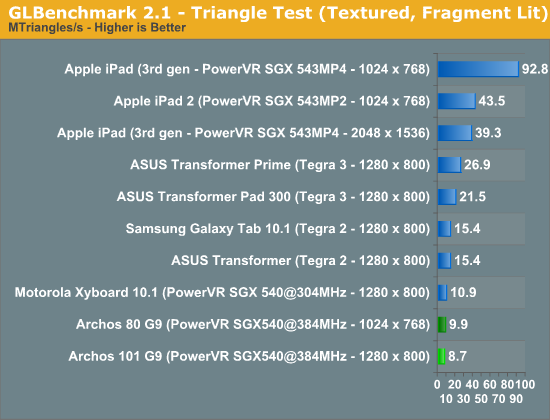
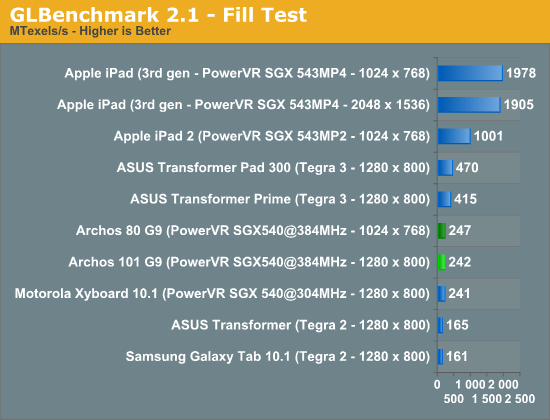










39 Comments
View All Comments
hans007 - Thursday, May 24, 2012 - link
the screen isnt TN. Its MVA. has much better viewing angles than the TN screen tablets like the acer ones.Rick83 - Wednesday, May 23, 2012 - link
there is a full size USB-port which works as such (once enabled by the "enable 3G port" button), besides allowing the use of the 3G sticks on (some?) GSM networks.You can plug external hard drives, USB hubs, USB HID devices and even some DACs into that port, and they will work as expected.
That port is, next to the media playback and the high end CPU one of the key features of the device, and shouldn't be put aside erroneously.
On the other hand, the test lacks the current problems of the device: WPA was broken for quite a while, GPS can be flaky and HDMI was also having issues in the last firmwares.
Also, Archos positions itself as a "feature device" in my opinion. It doers a lot, but it doesn't do many things very well, and testing isn't as exhaustive as elsewhere.
Impulses - Wednesday, May 23, 2012 - link
Most tablets without full sized USB ports still allow the same functionality thru a $15 adapter, at least Samsung and ASUS do.JasonInofuentes - Wednesday, May 23, 2012 - link
I tried to connect a device to the rear full-sized USB on each of the devices, and wasn't pleased with the fit. These ports are designed for one use and trying to squeeze a simple USB cable in was awkward at best. We try to return review devices unmarred, so I wasn't interested in testing that port much. I am confident that it and the microUSB port would be good for external storage.I didn't test earlier versions of the device and had no trouble with my WPA2 set-up. As for GPS, I dont consider it an integral part of the tablet experience and made no effort to use it. If readers want us to test GPS on every device I will give it a try. And I didn't encounter any issues with the HDMI testing, though it was limited to ensuring it worked on my TV.
I have to disagree that Archos "doesn't do many things very well" because of two key things they are doing well. These tablets are the only ones I would even bother considering doing our Media Test Suite on; that's a big plus. Further, they're willing to push updates and respond to issues quickly. During testing we received two updates which primarily dealt with bugs and tweaking features. HDMI is one of the most difficult connectors to work with because HDCP handshake issues can be borked with the smallest changes. If there were issues in the most recent firmwares, I'm confident Archos will address them. If all this bug chasing is a result of inexhaustive testing, well, at least they're fixing problems as they come up.
Thanks for the comments, keep them coming.
Rick83 - Thursday, May 24, 2012 - link
Some other features, that are not common to all tablets and probably missing in the review are out of the box NTFS and CIFS support.Also the USB-DAC support is unique to the Archos tablets.
I also explicitely added the "many" to that quote, because they do some things much better than others, but those are their defining features. On the wider front, their development is understandably rushed and falls short on testing (like the "bubble" issue on the first wave of hardware, where the back was not sufficiently tough to prevent stresses from holding the device to create screen artifacts. Also, it's great to have that awesome video codec support (also thanks to the OMAP 4460 and it's great decoding engine), but the HDMI issues (which are being fixed for the most part) are lessening the impact of being able to play 1080p30.
I've followed the reception of the device for a while, (waiting for another 5 inch device to make it to market) and while the regular updates are helpful, oftentimes they have to fix grave issues introduced by the previous one.
Owning an Archos is always a mixed bag, but it's probably the closest you can get to owning a PC in the tablet space, as the amount of features and the lack of custom "enhancements" to the UI give you a clean basic system, with a lot of freedom to tinker, and great support for ROM developers.
This is refreshing, because all the other tablet vendors just strive to be the next Apple, dumbing the UIs down (eg. "simplifying") and going for maximum lock-in. On the other hand, testing is usually quite good, so that things work out of the box, and not a year after release and at 85%.
Anyway, it's great to finally see a review of the "ultimate G9", even if it's a bit light no the "history" these devices have.
g00ey - Saturday, May 26, 2012 - link
I've been wondering for a while how you can safely use you're home computer as a media server for your portable device with which you roam around freely around the country and cross-country while listening to music or watching a movie that is on your home-drive.I'm not sure if CIFS is such a good idea to share things over the internet. In a closed network? yes, in a more open network over the internet? Presumably no.
If I were to share over the net I would prefer a secure connection which rules out the http and ftp protocols. I've tried to mount sftp and ssh volumes over the Internet but the performance is really bad.
Penti - Tuesday, May 29, 2012 - link
You probably already use it on your internal network on your NAS for your media though. Just load it over to your device for when not home or use like WebDAV or something. Or just use some DLNA-solution. You'd be fine as long as you connect to a VPN. If it's fast enough is another matter, but a DLNA-server can encode and stream it. Not supporting it (SMB/CIFS) is a pain when your home and want to access your media.michael2k - Wednesday, May 23, 2012 - link
A better screen would have made this an ideal in car entertainment center!Without the extra brightness and viewing angles, however, it just can't be used for such. Oh well.
npaladin2000 - Wednesday, May 23, 2012 - link
I bought one of these. Nice media device, good for gaming. The 8 inch one is a nice size for eReading too, with the nook and Kindle apps. That's my primary use for it, that and some Tapatalk. it's unfortunate that some games don't take full advantage of the 4:3 screen, but the 16:9 stuff works well enough. And it's nice to be able to buy a STOCK ICS device.I do get wierded out by the viewing angles at times, but only when I'm holding it in my hands. The kickstand does a good job of keeping it at a viewable angle. And I can usually easily adjust my grip to get a viewable angle as well.
frozentundra123456 - Wednesday, May 23, 2012 - link
I bought an Acer 7" Iconia tablet with no 3G option because I thought it would not matter. However, I have found it to be a major shortcoming and I would not purchase another tablet without some sort of 3G or 4G connectivity. The major advantage of a tablet is portability, but without some sort of data plan, when you are on a trip, travelling around, the tablet is worthless, when the portability should make it the ideal choice. (I dont really play games on it or watch videos, mainly use for e-mail, web browsing, GPS)I guess you would not necessarily expect 3G at these prices, but it is a critical function to me after living without it.
And I know you can purchase a hot spot device, but who wants to carry around another device just to get connectivity.